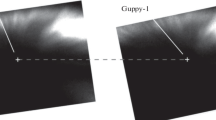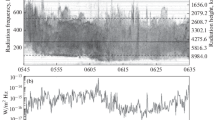Abstract
The possibility of evaluating the energy spectra of precipitating electrons which form rayed auroral structures has been substantiated. The data of triangulation observations by equipment recording radiation in a wide range of wavelengths (380–580 nm) have been used. A technique for calculating the height profiles of deposition energy from the height profiles of the volume emission rate recorded by the receiving equipment. The energy spectra of precipitating electron fluxes responsible for the formation of rayed structures in auroras have been reconstructed. It is shown that the energy spectra of the precipitating electron flux can be approximated by the sum of two electron fluxes having a power-law energy spectrum and a Maxwellian energy distribution. It has been suggested that radiant structures in auroras are formed due to the discharge of electrons into the ionosphere, which have a power-law energy distribution.






Similar content being viewed by others
REFERENCES
Ivanov, V.E. and Kozelov, B.V., Prokhozhdenie elektronnykh i protonno-vodorodnykh puchkov v atmosfere Zemli (Passage of Electron and Proton-Hydrogen Beams in the Earth’s Atmosphere), Apatity: Kol’sk. Nauchn. Tsentr, 2001.
Kozelov, B.V., Dashkevich, Zh.V., and Ivanov, V.E., Study of radiant structures by triangulation methods: 1. Radiation intensity, Kosm. Issled., 2021, vol. 59, no. 4 (in press).
Jones, A.V., Aurora, Boston: D. Reidel, 1974.
Dashkevich, Zh.V., Ivanov, V.E., Sergienko, T.I., and Kozelov, B.V., Physicochemical model of the auroral ionosphere, Cosmic Res., 2017, vol. 55, no. 2, pp. 88–100.
Hedin, A.E., Extension of the MSIS Thermosphere Model into the middle and lower atmosphere, J. Geophys. Res., 1991, vol. 96, pp. 1159–1172.
Dashkevich, Zh.V. and Ivanov, V.E., Estimate of the NO concentration in the auroral region based on emission intensities of 391.4, 557.7, and 630.0 nm, Cosmic Res., 2017, vol. 55, no. 5, pp. 318–322. https://doi.org/10.1134/S0010952517050045
Swider, W. and Narcisi, R.S., Auroral E-region: ion composition and nitric oxide, Planet. Space Sci., 1977, vol. 25, pp. 103–116.
Dashkevich, Zh.V. and Ivanov, V.E., Estimated nitric oxide density in auroras from ground-based photometric data, Sol.-Terr. Phys., 2019, vol. 5, no. 1, pp. 58–61.
Author information
Authors and Affiliations
Corresponding author
Rights and permissions
About this article
Cite this article
Dashkevich, Z.V., Ivanov, V.E. & Kozelov, B.V. Studying Rayed Structures in Auroras by Triangulation Methods: 2. Energy Spectra of Precipitating Electrons. Cosmic Res 59, 307–311 (2021). https://doi.org/10.1134/S0010952521050038
Received:
Revised:
Accepted:
Published:
Issue Date:
DOI: https://doi.org/10.1134/S0010952521050038




